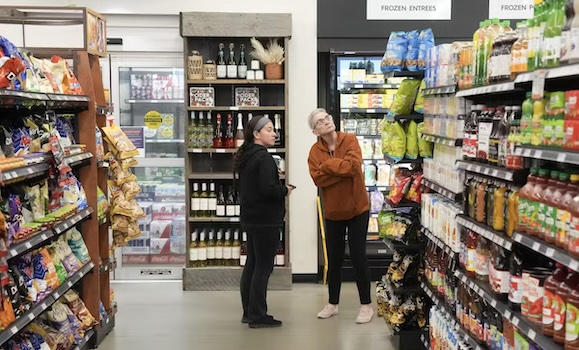, Associate Professor, Sociology and Social Anthropology and Canada Research Chair in Sustainable Rural Futures for Atlantic Canada,Ìı;Ìı, Postdoctoral Fellow, Common Ground Canada Network,Ìı;Ìı, Professor of Political Science and Global Development Studies,Ìı, andÌı, Professor, Sustainable Food Systems,Ìı
ÌıÌı
Rising tensions between Canada and the United States have made increased military investment and a renewed focus on national defence all but inevitable.
A recent Angus Reid poll found in response to as the 51st state. In early March, former prime minister Justin Trudeau to increasing military spending.
While it makes sense for a country feeling vulnerable to invasion to look at recruiting new soldiers and increasing its arsenal, there is an additional facet of national defence that is too often overlooked: food preparedness.
are already ââ in Canadians and , but food should be part of the national defence conversation, too.
The double edge of globalization
ÌıÌı
The globalization of food systems, in Canada and the rest of the world, has . This has brought some benefits, such as year-round access to fresh produce, but it has also made Canadaâs food systems vulnerable to the whims of its trading partners.
Academics focused on food security and sovereignty have about .
Even in 2021, when the COVID-19 in Canada, research showed that the production of fresh produce was .
Now, faced with both and , Canada must confront whether its domestic food systems can feed its population in a crisis â economic, political, environmental or otherwise.
Food systems and national defence
ÌıÌı
Trade-dependent countries worldwide are recognizing food security as a matter of national defence. Some, like Sweden, are making plans to take stock of the capacity and resilience of their food systems, and actively working toward a system that can sustain the lives of their citizens in a crisis.
Swedenâs total goods trade accounted for , compared to Canadaâs 53 per cent. Despite its high level of trade dependence, at the heart of the countryâs total defence approach to national security.
is a defence policy that emphasizes both traditional military activities and civilian activities, including their food systems.

Swedish Defence Minister Pal Jonson speaks to the media after a ceremony marking the integration of the Swedish Mechanized Infantry Battalion into the NATO Multinational Brigade at the Adazi military base in Latvia n February 2025.Ìı(AP Photo/Roman Koksarov)
Ìı
The Swedish government, , states: âA well-functioning and robust food supply and personal preparedness of the civil population are ultimately a matter of survival and maintaining the will to defend.â
This approach is not focused only on individual or household levels of preparedness â that is, whether people have enough in their pantries â but also includes the overall preparedness of the systems that produce, process and distribute food.
Canada, with its heavy reliance on global trade and the U.S. as a primary trading partner, would do well to take note.
Food sovereignty in Canada
ÌıÌı
There are hundreds of scholars and thousands of community entities working to make Canadaâs food systems more sustainable and resilient in the face of , and the .
In Québec, for example, there is a growing movement to mobilize and empower producers, community entities, the agrifood sector, policymakers and additional stakeholders to build more across the province.
Canadian experts play a key role in global discussions on food systems resilience, with scholars contributing to the . This report is designed to help countries make their food systems more resilient, equitable and sustainable.
Yet Canadaâs efforts are not co-ordinated, empowered or moving fast enough in the push for greater food sovereignty. The point is not to abandon trade, but to manage it more strategically.
Both international and domestic markets are , and many local companies are devoted to importing everyday goods like coffee, tea and bananas under and .

Customers shop at a grocery store in Sharon, Ont., in November 2024.ÌıTHE CANADIAN PRESS/Chris Young
Ìı
Trade relations, however, are about more than economics; they involve building political partnerships with Mexico, the European Union, Asian countries and beyond â something Canada needs now more than ever.
Sweden has already recognized this. Its food preparedness strategy involves with like-minded Nordic countries and collaborating around the supply, transport, stockpiling and testing of food.
Crisis-proofing Canadaâs food systems
ÌıÌı
To ensure Canada can feed itself in a crisis, the government must invest in domestic production, processing and distribution infrastructure. This would create more efficient, connected local markets that removes some of the burden of buying local .
The Canadian government must also promote diversification in production and export. Canada needs to move away from monoculture farming and . These approaches are more resilient to both crops themselves and the diverse markets they open up, reducing Canadaâs dependence on single trading partners like the U.S.
Key agricultural policies such as the need to go beyond the long-standing focus on prioritizing export markets. They must also invest in infrastructure and partnerships in Canada to strengthen their support of Canadian producers, ranchers, fisheries and food system players at home, to help them work together at a regional scale.
Correcting power imbalances in our food systems is also critical. Greater over how food is produced, processed and distributed would help with this. These strategies would make Canada less vulnerable to supply chain disruption.
Countries like Sweden recognize these efforts as part of national defence â an approach Canada should consider.
But while we fight annexation from the kitchen table, we must recognize it doesnât start there; it starts at a higher level. Only better policy, infrastructure and systemic change can prepare Canada to be more proactive and resilient in the face of world crises â economic or otherwise.![]()
This article is republished from under a Creative Commons license. Read the .

